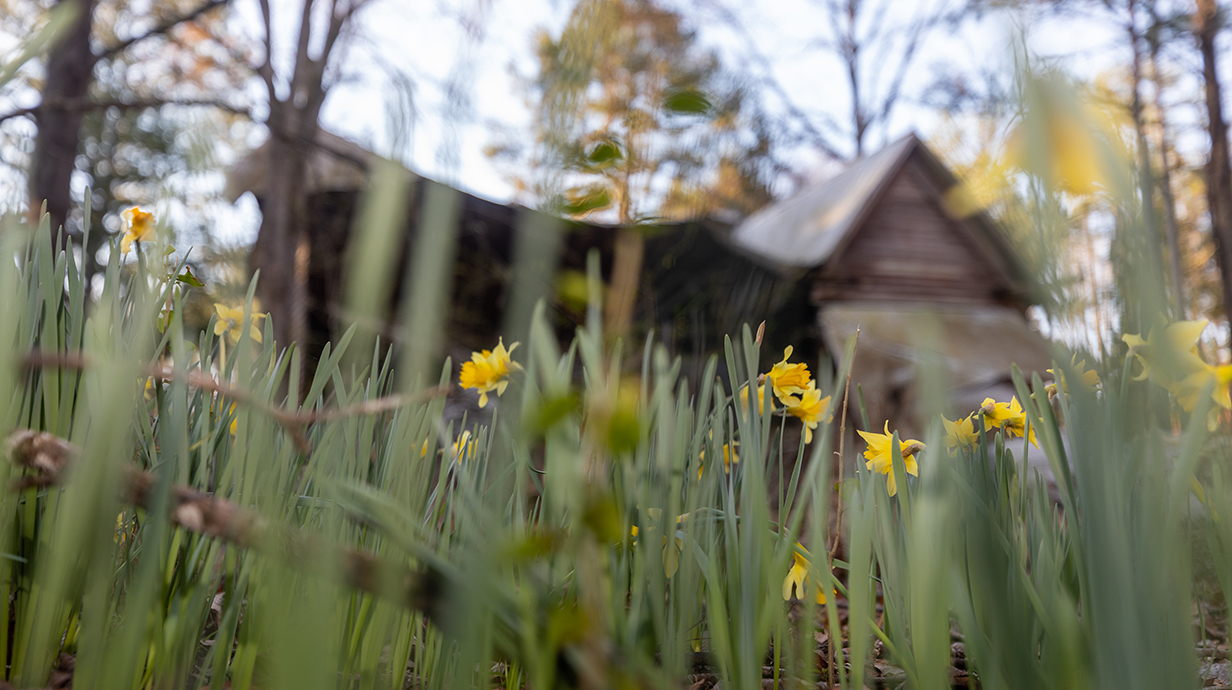Photo Documentary to Show History, Beauty of Greenfield Farm
Photographer Thad Lee to record farm through the seasons

OXFORD, Miss. – A grant from the Mississippi Hills National Heritage Area will fund a photo documentary project on Greenfield Farm, the future home of Mississippi's first writer's residency.
Greenfield Farm was once home to Pulitzer Prize-winning author William Faulkner's mules, chickens and other farm animals. The land – just 15 miles northeast of Oxford – was acquired by the University of Mississippi and will soon become an inspiration to a new generation of authors.

Daffodils grow in the ruins of Greenfield Farm. The flowers are evidence that there was once an abundant life on the dilapidated property, which the university plans to renovate into a writers' retreat. Photo by Thad Lee
Before renovation begins, however, the university's Mississippi Lab wants to document the farm as it is.
"We've been working on developing the residency at Greenfield Farm for several years now," said Mary Wise Conaway, project manager for the Mississippi Lab. "The land has such strong ties to Faulkner's legacy and to the university, and this is an opportunity to document the farm as it is right now, before we break ground and before all those plans for the residency are put into motion."
The Mississippi Lab has partnered with Thad Lee, a documentarian and photographer, to chronicle the natural beauty of the timeworn property through a grant from the Mississippi Hills National Heritage Area.
Since early January, Lee has been photographing the seasons at Greenfield Farm. Lee, a longtime Faulkner reader, said he's excited to be able to preserve some of the original structures, flora and mystique of the property through his work.

"When they asked me to do this, I jumped at the chance," he said. "You get out here and realize how far away you are from the rhythms of town, and Faulkner knew that.
"There's a brilliant quiet, and Greenfield Farm is going to be able to share that with writers. They will be able to explore this place and discover what made it so special to Faulkner."
Lee's experience with documenting landscapes made him the perfect person to join the Mississippi Lab on the project, Conaway said.
"At the end of this project, we'll be developing a digital repository of his work to share with the public," she said. "That's going to be available on the Mississippi Lab website and through eGrove. We are at work on plans for exhibits, too."
Daffodils are already growing wild near one of the buildings, rusted farm equipment is growing over with weeds and myriad pieces of the past lie left behind, Lee said.
"At some point, someone planted those daffodils," he said. "There was once rich life here. This is a project that is going to cover the farm in this incredible transitional state from it being a place that hasn't been tended in years, that has been partially reclaimed by the woods, to being a place where writers live again.
"The property has a wildness about it, but there are also structures that were there that belonged to Faulkner. I want to capture the marriage between the wilderness and the ruins."
Top: Hannah McCormick, a UM graduate who paints and teaches in Water Valley, paints one of the remaining structures at Greenfield Farm, a tract near Oxford that was once William Faulkner’s mule farm. A new project funded by the Mississippi Hills National Heritage Area will document the seasons on the farm, which the university plans to renovate into a writers' retreat. Photo by Srijita Chattopadhyay/Ole Miss Digital Imaging Services
